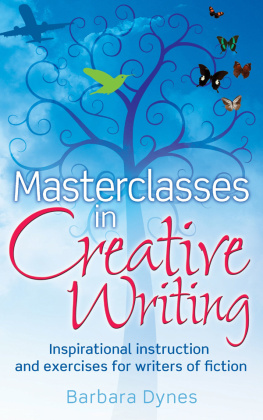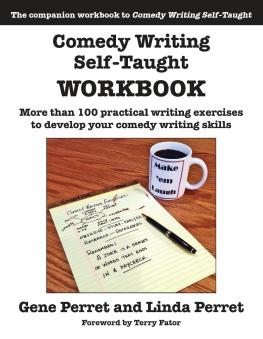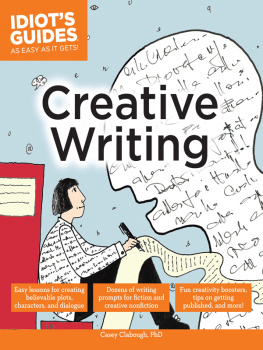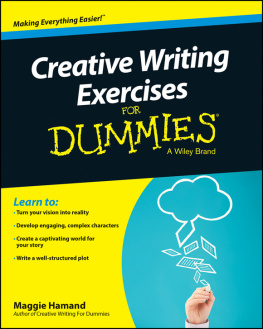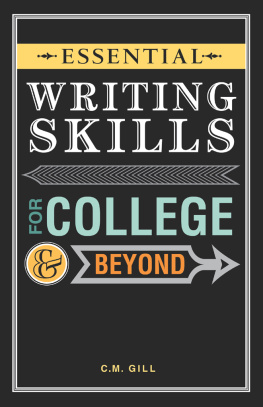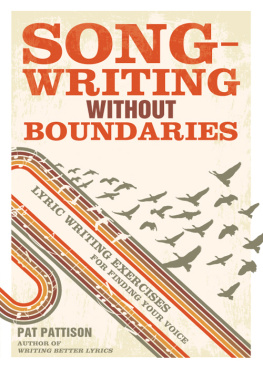A Year Of Weekly Writing Exercises
Avril Sabine
Cracked Acorn Productions
Australia
A Year Of Weekly Writing Exercises
Published by
Cracked Acorn Productions
Gympie, Queensland 4570
Australia
978-1-925131-80-2 (Kindle)
978-1-925131-81-9 (EPUB)
Genre: Creative Writing (Nonfiction)
Copyright 2016 Avril Sabine
Cover design by Caitlyn Petersen
All rights reserved
To the many people who have attended my workshops and shared stories of their journey with me.
Contents
Looking for ways to practice and improve your writing skills? An exercise a week to help you hone your skills might be exactly what you need. These exercises have been collated from workshops run by Avril Sabine where she has shared some of her knowledge gained from decades of writing.
*
This book was written by an Australian author using Australian spelling.
These exercises have been created to help you improve and practice your skills as a writer. Not only is it important to practice, its also good to sometimes step outside your comfort zone and genre to challenge yourself.
Throughout these exercises I sometimes ask you to focus exclusively on one technique, using no others. This is to learn or gain a better understanding of that particular technique, not because its the only technique to use when writing stories. Its to give you a larger range of well-honed techniques and skills to draw upon when you are writing.
Think about when you were first learning to write the alphabet and you drew each letter over and over again. Reforming it until it was as perfect as you were able to make it. The more you practiced that particular letter, the better you became at it. Eventually you put those individual letters together and made words and finally sentences. This is what Id like you to achieve by focusing on different techniques. Improving them individually so that when you put them together your writing is better for having learned and practiced each new skill.
Every week there is a new exercise for you to work on. You can do the exercise once or several times. Or even once a day throughout each week. Like any skill, the more you practice the more likely you are to improve. Each exercise is categorised so you know the main area youll be working on for that exercise.
There are no word limits. Write as many or as little words as necessary for each exercise. Sometimes you might find yourself writing a hundred words. At other times you might write several thousand. Dont be concerned with how many words it takes to complete each exercise. Use however many are necessary.
Characters
Dialogue
Editing
Generating Ideas
Genres
Plots
Point Of View
Setting
Time Management
Category: Characters
Details: It isnt only in times of great adversity that your characters can show their depths.
Exercise: Write a scene showing a trait of your character. It can be a moment of action, but make it a moment without high stakes.
Category: Point Of View
Details: Point of view can change the feel of a story.
Exercise: Write the same scene from two separate points of views. (eg First person point of view and third person point of view).
Category: Genres
Details: Focusing on what you like about different genres can help you figure out which one or ones youd like to write in.
Exercise: Which genre or genres are you drawn to, or tend to read in, and why.
Category: Generating Ideas
Details: Random words can be used to create unexpected stories and scenarios.
Exercise: Use a dictionary to randomly choose antagonist, protagonist and conflict to come up with a story idea.
Category: Characters
Details: Physical attributes mean more to the reader if they mean something to the character.
Exercise: Write a scene showing how a character feels about one of their physical attributes. Make sure it is showing, not telling. It can be either a positive or negative feeling.
Category: Time Management
Details: It can take time and practice to start new routines and habits.
Exercise: For one week find ten minutes each day to write. If you reach the end of those ten minutes and still have time and the words are flowing, keep going. Theres no need to stop if you dont have to.
Category: Dialogue
Details: By having your character interact with their environment, it can reduce the need for speech tags and paint a clearer picture of their location.
Exercise: Write a scene between two characters without using said or any of its many various forms such as whispered, shouted or asked. Make sure its always clear who is speaking.
Category: Characters
Details: What drives your character?
Exercise: What does your character want? Why do they want it? Whats stopping them from getting it? What are they willing to do to get what they want? What arent they willing to do to get what they want? What situation would make them cross or think about crossing this line?
Category: Generating Ideas
Details: Real life can be a great source for inspiration when creating ideas.
Exercise: Choose a newspaper article, or several articles, and create your own scenario from only the title.
Category: Plots
Details: Planning can help you work out how to create your own plot twist.
Exercise: What is the logical conclusion to your story? How can you twist this and what could you change to make the ending unexpected? Are there several possibilities?
Category: Characters
Details: Possessions can say a lot about characters.
Exercise: Portray your character by using items your character owns or carries with them.
Category: Point Of View
Details: Playing with point of view can be a way to figure out what isnt working in a story or discover if you have the correct point of view character. Trying out different points of view may show you aspects of that point of view that work well with your style of writing.


